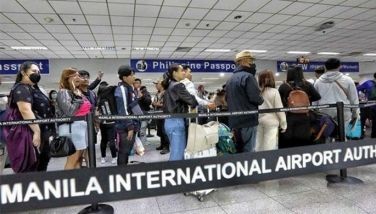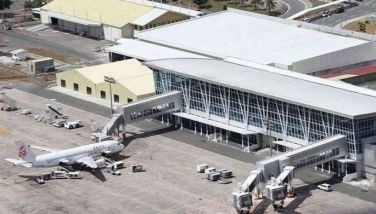The President's Bridge Program: A catalyst for economic growth (Part II)
Manila, Philippines - Farmers in upland Aklan, Capiz and Antique have used bridges to bring their produce down the Madya-as Mountain Range and other hilly areas where a variety of crops and abaca are grown.
DAR officials said they prefer steel bridges rather than the traditional bridges built by contractors that had already incurred P3 billion in overruns and subject to a bridge replacement project costing P950 million.
The argument aired by DAR and DA officials is that durable bridges are needed in the face of typhoons that average 27 annually and weaken an estimated 10,000 lineal meters each year.
The PBP was established precisely to reduce the backlog of 15,000 or about 200,000 lineal meters of local and national bridges based on the Medium-Term Philippine Development Plan (MTPDP).
Support services to farmers covered by agrarian reform include the provision of stronger bridges, preferably those designed to handle a load of 80 metric tons (MT) as against the traditional 25 MT since it allows a bigger volume of cargo to be transported daily.
Modular steel bridges can also be repaired easily and lanes could be added quickly, an advantage not enjoyed by traditional bridges.
Just how durable are these modular steel bridges compared to reinforced concrete? The French supplier guarantees their bridges to withstand up to two million vehicle cycles for 100 years. The spans are rated for 60-80 tons, and have anti – skid coating that is resistant to cracking and shrinkage. Bridges using the old reinforced concrete – based technology are subject to cracking (especially during calamities). The quality is hard to police, as the concrete will conceal substandard materials such as undersized steel reinforcements, or poor workmanship.
The modular bridges are described as “wonder bridges” given the completion time of from one week to three months. This is due to the modular versatility of the French supplied bridging materials. The reinforced concrete bridge which takes three to five years to complete or the massive steel trussed bridge, are difficult to transport and install in rugged rural areas.
Former Senate President Aquilino “Nene” Q. Pimentel Jr. even called for more bridges, stating that it is the role of government to provide infrastructure linkages, for “these will spur sustained socio-economic development.”
“Bridges are essential elements to complete farm-to-market roads networks, especially in rural areas,” he said. He lauded the President’s Bridge Program’s performance but adds that so much more needs to be done.
In line with the current administration’s stance of Daang Matuwid, which is to establish big-ticket infrastructure programs at the “right cost, right place, right time,” he suggested that the country seek out foreign donor bridge suppliers using official development assistance (ODA) loan packages.
According to Pimentel, these loans are concessional in nature or “soft,” offering much lower interest rates and longer terms compared to suppliers using commercial loans. This claim is supported by the DPWH, whose figures show one French donor supplier using a 10-year loan inclusive of a six-year grace period, at 2.5 percent interest, and guaranteed by the French export credit agency, COFACE.
“This is clearly advantageous to the government,” said the former senator.
Comparatively, commercial loans used by other suppliers generally offer from two to five year terms, with interest ranging from 3.1 percent to 5.97 percent.
The former lawmaker emphasized that people need to look beyond the unit costs of infrastructure. “These structures pay for themselves many times over their life span,” he said. “The return on the country’s investment can be measured in providing better lives, better livelihoods, development at the barangay and municipal level, increased productivity and output and tourism,”
“That too is in the best interest of government,” he concluded.
The PBP also boosted peace and order efforts in Mindanao as 89 bridges called Salam (Peace) Bridge Project or Bridges for Peace were built in four war-torn ARMM provinces. There were also 593 bridges called Bridges of Hope erected in Mindanao and Palawan.
Annually, the Philippines is visited by more than 22 typhoons and other natural calamities that destroy or damage some 10,000 lineal meters of existing bridges. Even if foreign donor countries can supply an average of 20,000 lineal meters of bridges, there is still some 170,000 lineal meters of bridging required to be urgently constructed based on the 1994 NEDA approved master plan of bridges.
The PBP has been made possible through concessional ODA from foreign governments. The PBP initially came from the United Kingdom government and expanded to include the governments of Austria, France, Spain, Korea and Japan.
All PBP projects pass through assessment and approval by the National Economic and Development Authority Investment Coordinating Committee (NEDA-ICC). The NEDA-ICC is composed of 12 major line departments of the government with three levels of review and approval: Technical Committee; Cabinet Committee; and the NEDA Board chaired by the President. Prior to its approval, NEDA will take into consideration a representation by the DPWH that it has taken due diligence in comparing options in establishing the technical advantages and cost effectiveness of the bridge technology from the various bridge suppliers.
The project then goes to the Department of Finance and the Monetary Board for approval. Once approved, the Department of Justice does a final review before final approval.
Under the present administration, the Secretary of the Public Works and Highways leads the Oversight Committee that oversees the implementation of the project with ex-officio members composed of the Secretaries of the Departments of Finance, Foreign Affairs, Socio-Economic Planning, Public Works and Highways and Interior and Local Government. The Commission on Audit assists the committee to ensure that there is transparency and accountability.
(To be continued)
- Latest
- Trending





























